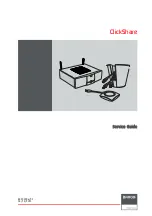
13
TANDBERG
FieldView Administrator Guide
D14098.02 June 2008
Radio Frequency Channel Selection
The 802.11b/g wireless interface operates in the unlicensed 2.4 GHz frequency
spectrum. Up to 14 channels are allocated within this spectrum. The number
of channels varies with the region (e.g. 11 channels in North America, 13
channels in most of Europe, etc.)
Unfortunately, not all of the channels can be used at a single geographic
location because, while each channel consumes over 22 MHz of bandwidth, the
channels are only separated by 5 MHz. This channel overlap is illustrated in Fig.
3-1.
Overlapping channels cause interference resulting in degradation of quality
and throughput. As shown in the diagram, channels must be separated by a
minimum of five channels to ensure interference does not occur. This limits the
maximum number of channels that can be used in close proximity to three.
In North America, the only option for more than two non-overlapping channels
is to choose channels 1, 6, and 11. In other regions of the world, the additional
available channels allow other choices but the three channel limit still exists.
Notes
:
Further complicating channel selection is the possibility that a neighboring
•
site may use one or more channels that conflict with the channels in use at
a given location.
Existing infrastructure at some sites violate channel overlap rules without
•
realizing it. The network may appear to work fine with data but won’t be
sufficient for real-time media. Network monitoring may show:
Degraded signal quality resulting in lower transmission rates.
•
Packet errors resulting in frequent 802.11 retries.
•
Data operations tend to occur in bursts which lower the likelihood for
•
collisions when compared to voice and video which require a continuous
and regular packet stream.
Robust high level protocols such as TCP/IP mask overlap problems
•
because lost packets are automatically recovered. Although performance
degradation occurs, it may not be readily apparent for file transfers,
downloads, etc. because the operations will eventually succeed.
Interference
As discussed above, interference from adjacent channels can cause problems
with wireless performance. Unfortunately, there are other sources of
interference within the unlicensed 2.4 GHz RF band utilized for 802.11b/g
WLAN operation. Interference sources include:
Microwave ovens
•
2.4 GHz cordless phones
•
Bluetooth devices
•
802.11 Frequency Hopping devices
•
Other 802.11b/g equipment (APs, client devices) on overlapping or
•
improperly separated channels
A variety of other 2.4 GHz equipment
•
Where possible, interference sources should be minimized. If that is not
possible, other strategies such as channel remapping or relocation may
be considered. A site survey (as discussed in
Site Survey
) is useful in
understanding and resolving interference issues.
Chapter 3
















































